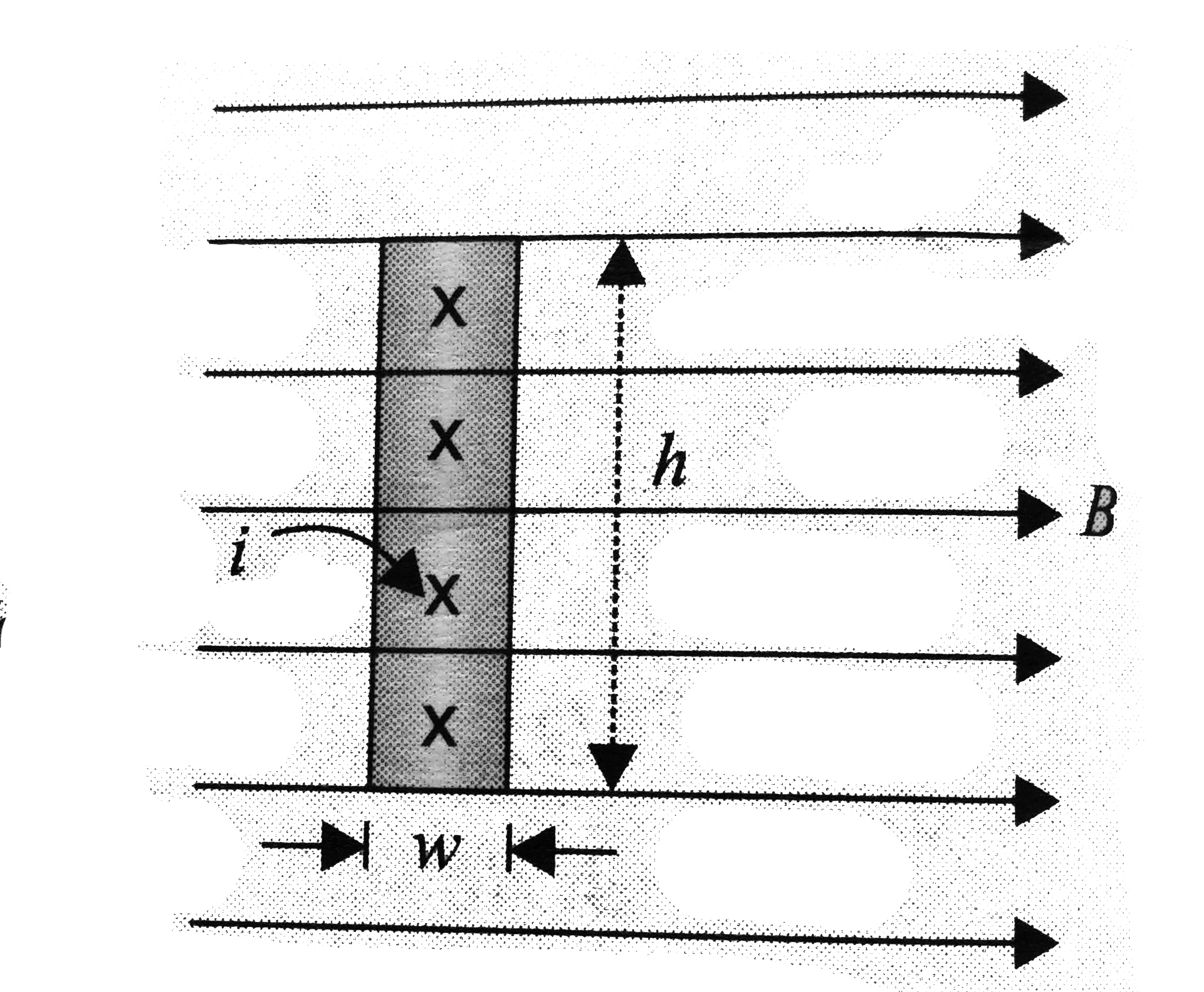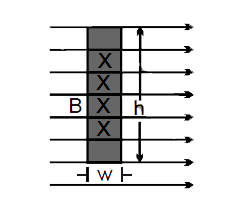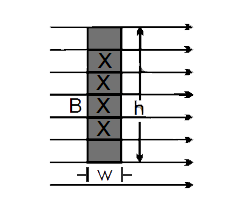A current i, indicated by the crosses in figure, is established in a strip of copper of height h and width w. A uniform field of magnetic induction B is applied at right angle to the strip.
(a) Calculate the drift velocity vd of the electrons.
(b) What are the magnitude and direction of the magnetic force F acting on the electrons?
(c) What should the magnitude and direction of a homogeneous electric field E be in order to counterbalance the effect of mangetic field?
(d) Calculate voltage V necessary between two sides of the conductor in order to creat this field E Between which sides of the conductor would this voltage have to be applied?
(e) If no electric field is applied from the outside, the electrons will be pushed somewhat to one side and therefore will give rise to a uniform electric field EH across the conductor until the forces of this electrostatic field EH balance the magnetic forces encountered in part (b). What will be the magnitude and direction of field EH?
Assume that n, the number of conductor electrons per unit volume is 1.1×1029m−3,h=0.02m,w=0.1cm,i=50A,andB=2T.

The correct Answer is:[(a) 1.4×10−4m/s ; (b) 4.5×10−23N (in downward direction); (c) 2.8×10−4V/m ; (d) 5.8×10−6V, Top voltage should be positive and bottom negative ; (e) 2.8×10−4V/m]
Step by step video, text & image solution for A current i, indicated by the crosses in figure, is established in a strip of copper of height h and width w. A uniform field of magnetic induction B is applied at right angle to the strip. (a) Calculate the drift velocity v_d of the electrons. (b) What are the magnitude and direction of the magnetic force F acting on the electrons? (c) What should the magnitude and direction of a homogeneous electric field E be in order to counterbalance the effect of mangetic field? (d) Calculate voltage V necessary between two sides of the conductor in order to creat this field E Between which sides of the conductor would this voltage have to be applied? (e) If no electric field is applied from the outside, the electrons will be pushed somewhat to one side and therefore will give rise to a uniform electric field E_H across the conductor until the forces of this electrostatic field E_H balance the magnetic forces encountered in part (b). What will be the magnitude and direction of field E_H? Assume that n, the number of conductor electrons per unit volume is 1.1xx10^(29) m^-3, h = 0.02 m, w= 0.1 cm, i = 50 A, and B=2 T. by Physics experts to help you in doubts & scoring excellent marks in Class 12 exams.
Updated on:21/07/2023Topper's Solved these Questions
- MAGNETIC EFFECTS OF CURRENT AND MAGNETISMBOOK - PHYSICS GALAXY - ASHISH ARORACHAPTER - MAGNETIC EFFECTS OF CURRENT AND MAGNETISMEXERCISE - Advance MCQ
29 Videos
- Kinetic Theory of Gases and Gas LawsBOOK - PHYSICS GALAXY - ASHISH ARORACHAPTER - Kinetic Theory of Gases and Gas LawsEXERCISE - Unsolved Numerical Problems for Preparation of NSEP, INPhO & IPhO
64 Videos
- NUCLEAR PHYSICS AND RADIOACTIVITYBOOK - PHYSICS GALAXY - ASHISH ARORACHAPTER - NUCLEAR PHYSICS AND RADIOACTIVITYEXERCISE - Concptual MCQs
48 Videos
Similar Questions
Consider two rings of copper wire. One ring is scaled up version of the other, twice large in all regards (radius, cross sectional radius). If current around the rings are driven by equal voltage source then choose the CORRECT alternative(s). Assume that cross-sectional radius is very small as compared to radius of rings :
View SolutionAn electron tube was sealed off during manufacture at a pressure of 1.2×10−7 mm of mercury at 27∘C. Its volume is 100 cm3. The number of molecules that remain in the tube is
View SolutionA radioactive element .90X238 decay into .83Y222. The number of β−particles emitted are.
View SolutionA current i, indicated by the crosses in figure, is established in a strip of copper of height h and width w. A uniform field of magnetic induction B is applied at right angle to the strip. (a) Calculate the drift velocity v_d of the electrons. (b) What are the magnitude and direction of the magnetic force F acting on the electrons? (c) What should the magnitude and direction of a homogeneous electric field E be in order to counterbalance the effect of mangetic field? (d) Calculate voltage V necessary between two sides of the conductor in order to creat this field E Between which sides of the conductor would this voltage have to be applied? (e) If no electric field is applied from the outside, the electrons will be pushed somewhat to one side and therefore will give rise to a uniform electric field E_H across the conductor until the forces of this electrostatic field E_H balance the magnetic forces encountered in part (b). What will be the magnitude and direction of field E_H ? Assume that n, the number of conductor electrons per unit volume is 1.1xx10^(29) m^-3, h = 0.02 m, w= 0.1 cm, i = 50 A, and B=2 T.
View SolutionWhat is the magnitude and direction of force on an electron moving along the direction of the magnetic field.
View SolutionAn electron beam enters a magnetic field right angles to it as shown in the Figure. The direction of force acting on the electron beam will be :
View Solutionएकसमान चुंबकीय क्षेत्र में गतिशील एक इलेक्ट्रॉन पर लगते चुंबकीय बल का परिमाण किस स्थिति में अभिकतम होगा ?
View SolutionIn a region, a uniform electric field and a uniform magnetic field are acting in the same direction. An electron is shot along the directio of the fields. What change will be obsverved in the magnitude and direction of the velocity of that electron ?
View SolutionA current I is passed through a silver strip of width d and area of cross-section A. The number of free electrons per unit volume is n If a magnetic field B exists in the region as shown in figure, what is the average magnetic force on the free electrons?
View SolutionA current I, indicated by the crosses in fig. is established in a strip of copper of height h and width w. A uniform field of magnetic induction B is applied at right angles to the strip. Calculate the drift speed v_(d) for the electrons.
View SolutionA current I, indicated by the crosses in fig. is established in a strip of copper of height h and width w. A uniform field of magnetic induction B is applied at right angles to the strip. What are the magnitude and direction of the magnetic force F acting on the electrons?
View SolutionA current I, indicated by the crosses in fig. is established in a strip of copper of height h and width w. A uniform field of magnetic induction B is applied at right angles to the strip. What would the magnitude & direction of homogeneous electric field E have to be in order to counter balance the effect of the magnetic field?
View SolutionA current I, indicated by the crosses in fig. is established in a strip of copper of height h and width w. A uniform field of magnetic induction B is applied at right angles to the strip.

What is the voltage V necessary between two sides of the conductor in order to create this field E?
View SolutionA current I, indicated by the crosses in fig. is established in a strip of copper of height h and width w. A uniform field of magnetic induction B is applied at right angles to the strip.

If no electric field is applied form the outside the electrons will be pushed somewhat to one side & thereforce will give rise to a uniform electric field EH across the conductor untill the force of this electrostatic field EH balance the magnetic forces encountered in part (b). What will be magnitude and direction of the field EH? Assume that n, the number of conduction electrons per unit volume, is 1.1×1029/m3 & that h=0.02 meter, w=0.1cm, i=50 amp, & B=2webers/meter2.
View SolutionAn electron is moving with a speed of 3.5xx10^(5) m//s when it encounters a magnetic field of 0.60 T. The direction of the magnetic field makes an angle of 60.0^(@) with respect to the velocity of the electron. What is the magnitude of the magnetic force on the electron ?
View SolutionAn electron enters a magnetic field at right angles
to it as shown in fig. The direction of the force acting on the electron will be :
(a) To the right , (b) to the left , (c) out of the page,
(d) into the page.

View Solution
